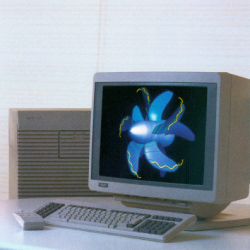Ever heard of Apollo Computer, Inc.? They were one of the first graphical workstation vendors in the 1980s, and at the time were competitors to Sun Microsystems.
 But that’s enough dry historical context. Feast your eyes on this full-color, 26-page product brochure straight from 1988 for the Series 10000 “Personal Supercomputer” featuring multiple processors and more! It’s loaded with information about their hardware and design architecture, giving a unique glimpse into just how Apollo was positioning their offerings, and the markets they were targeting with their products.
But that’s enough dry historical context. Feast your eyes on this full-color, 26-page product brochure straight from 1988 for the Series 10000 “Personal Supercomputer” featuring multiple processors and more! It’s loaded with information about their hardware and design architecture, giving a unique glimpse into just how Apollo was positioning their offerings, and the markets they were targeting with their products.
Apollo produced their own hardware and software, which meant much of it was proprietary. Whatever happened to Apollo? They were acquired by Hewlett-Packard in 1989 and eventually shuttered over the following decade or so. Find yourself intrigued? [Jim Rees] of The Apollo Archive should be your next stop for everything Apollo-oriented.
Vintage computing has a real charm of its own, but no hardware lasts forever. Who knows? Perhaps we might someday see an Apollo workstation brought to life in VR, like we have with the Commodore 64 or the BBC Micro (which even went so far as to sample the sound of authentic keystrokes. Now that’s dedication.)















I remember these. I did some rudimentary chip design on one for a course I did. Nice hardware.
Me too. We had one lab of them at Uni, and yeah chip design and emulation. 1991 I think.
Some staff/postgrads played x-tanks (networked) after-hours, and otherwise utilised the high quality graphics.
Same. We had a lab of HP apollos primarily to run mentor graphics for various CAD tasks. I did electronic schematic and PCB design followed by logic simulation and VHDL. This was University of Portsmouth (UK) between ’94 and ’99
I spent much of my early university career (1991-1993) trying to resurrect a pair of Apollo DN660s that had previously been used to design VLSI chips.
Fascinating notion of how nearly-seamless networking could have evolved, but didn’t.
Yes!
Spent several years as a co-op working with DN330 (monochrome), DN3000 (Motorola 68020/68881 with a whopping 16MB RAM and 4-bitplane color graphics (16 colors out of a palette of 24Million) , and a single DN580 (with a whole 256 color display!) all linked on an Apollo Token Ring network.
Weird, but fun, machines. Fully integrated multi-window graphics system with a special set of keys on the left side of the keyboard to do things like open windows and perform text editing functions. Domain/OS was like a funhouse-mirror version of UNIX.
There is an emulation of some 3000ish series systems available under the Mame emulator
https://wiki.mamedev.org/index.php/Driver:Apollo
the bonami game computer museum in the Netherlands has a DM560 coming from our hack42 collection. we never found the time to fix it. but the distinct Samsonite looks with wheels and hand cutout look awesome.
I’ve used Apollo workstations to design a printed circuit board a layouts and it was used by the vlsi design team for Asic designs. I remember them.
I got an DN3000 from the “Institut für leichte Flächentragwerke” (the architect dudes who designed the minimal surface roof on the Olympic Stadium in Munich). Could not use it much as a single machine but the graphics card had a standard ISA interface and worked beautfully with my i486 Linux box. We’re talking roughly 1990 here.
I felt like a king with my huge high resolution screen running simulation code written in Scheme and writing my papers in LaTeX.
I remember indeed the HP Apollo Series 700 workstation as my professor got one on his desk in 1993 or 1994. That it was the result of a merger is an interesting new information.
The Apollo deskside workstations were tall and slender, while the HP ones were cubic. The post-merger model 750 was clearly descended from both its parents…
https://www.hpmuseum.net/display_item.php?hw=1003
HP 9000/7xx were all PA-RISC and not compatible with DomainOS. The “Apollo” was in name only since HP killed off DomainOS and Prism shortly after acquiring Apollo, as is tradition.
I started with Unix system administration when the 3 first ( pre production i believe) Sun 1 workstations came to Sweden.
I installed the first Ethernet network for our
VAX 750 running BSD and the SUN, we also later got Apollos with Cadence cirquit board design.
We also had a Perq workstation for a while.
During many years I was involved in the system management for our worldwide network of many hundreds of SUN work stations for software developement and CAD.
I still remember ordering the the first 1 Mbit/s internet connection in the later part of the 1980s that was fully utilized and upgraded to 4mb within a week. That was fully used within 2 hours.
When I retired 9 years ago we mesured the connections in gigabits 😀
Played as a kid on one of these when I was visiting my father at work on the university. There were several of these in the room. My father called them mini-computers (as opposed to the regular micro-computers). What struck me that the displays were huge compared to normal micro-computer displays and full colour. I managed to find a game on it, some type of game to divide the play area to capture more ‘land’ and having to avoid enemies that can’t cross the line you’re drawing. Not sure what that game was called.
Would be interesting if someone could do a tear down of these machines.
The game sounds similar to Qix.
As an early 90’s sysadmin at a University, I LOATHED these things. While SunOS (as it was then), Dynix, UTS/M, UNICOS, Ultrix and Irix were all similar enough to support reasonable movement between them and could mostly interoperate well enough, these things were just islands of hassle. They were Unixish enough to be my problem (rather than the VMS team’s), but not enough to be convenient. Ugh. I wish I could forget them.
I ported network software to Apollo. I loathed Apollo too. A clone of VMS as an admin interface, with a clone of Unix BSD as the user interface. The Apollo OS was apparently a sort of micro-kernel architecture, probably too far ahead of its time for it own good. As far as I was concerned, it looked like Unix but did not behave anything like one. The TCP/IP subsystem was not stable under stress. Once crashed, no more network. No automatic restart.. Not an Apollo expert myself, I was just rebooting each time. Compare this to SunOS, which would run the stress test with no issues, and HP Unix, which would eventually return some errors but immediately recover.
I feel your pain brother – that pretty much mirrors my experience. Used them at ETA Systems to work on UNIX kernel porting for their super computers – worked mostly on the NFS support.
We had one, a 4000, I think it was, running the network management software for our x.25 network.
Great looking piece of kit.
It looked like a proper computer, much the same way the PET did.
I wonder if it was an Apollo token ring that Dilbert ((c) Scott Adams, of course) refers to back on May 2nd, 1996 when he tells his boss that:
1st frame:
HERE’S YOUR PROBLEM
THE CONNECTION TO THE NETWORK IS BROKEN.
2nd:
UH-OH. IT’S A “TOKEN RING” LAN, THAT MEANS THE TOKEN FELL OUT AND IT’S IN THIS ROOM SOMEPLACE.
In the last frame Wally says:
YOU ARE THE WIND BENEATH MY WINGS
And Dilbert replies:
I’LL WAIT A WEEK THEN TELL HIM THE TOKEN MUST BE IN THE “ETHERNET.”
To their credit, Apollo had an early system for parallel computing that let you break problems apart across multiple workstations. But it was ferociously cumbersome and (mercifully) replaced by PVM.
Wow. I saved that brochure from 1988. Still have it.
Big monitor and expensive-but-worth-it market segment is the impression I’m left with from a brief two weeks with an Apollo workstation in 1992.
My job at a desktop publishing software company involved porting a graphics library for client-side X windows rendering to a variety of workstations, and the Apollo was one of the machines in the lab.
I would run a test pattern to determine the frame buffer layout of each machine and then adjust parameters in the code to match the environment where it ran. The motivation for that approach came from the network latency inherent in server side X windows rendering.
We used those for IC design. They had no access control, so you could ‘creep’ (crp ? “Create Process” ?) onto someone else’s machine and play music, ‘melt’ the display or flip it upside down. New hires had no idea what was happening !
I remember the screen melt for their screen saver. At Sikorsky Aircraft in Stratford, CT, they had one. I was a consultant working on the old DEC System 10 to reverse engineer their GenHel (Helicopter Flight Simulation Software) that was written in DEC System 10 Assembler and then reprogram it into FORTRAN 77 on the new GOULD S.E.L. system running MPX 32 OS. This was 1986 to 1987.
Apollo 68K emulation exists in MAME
The Computer History Museum received permission to make 68K Apollo software and documentation available for non-commercial use back in the 00s. The software and docs are currently available via
bitsavers.org
Thank you Bill Poduska!
I was part of a group that used post-merger HP/Apollo workstations to write missile control software. By “writing”, I mean typing hex opcodes into an x-windowed text editor, and saving them as bin files, one function per file. These were then run through a simple routine to link… nay, concatenate all the various files in the right order to create a binary blob. Perhaps someone I wasn’t aware of was running a software-in-the-loop sim to test with. My experience was that we carried either fan fold printouts (patches) or an 8 inch floppy (a release) to the PDP-11 in the hardware-in-the-loop lab downstairs to check our work. Long story short, my gut feeling was that the workstations were an aspirational purchase for when we upped our game with more advanced engineering practices. But, in 1993, my and most of my mates s/w dev tasks didn’t need more than what a PC/AT or Mac Plus over LocalTalk could deliver.
The best thing I remember about the early Apollo workstations was that the built-in text editor supported rectangular cut and paste. It was years before it became available in Nedit (still one of my favorite editors!)